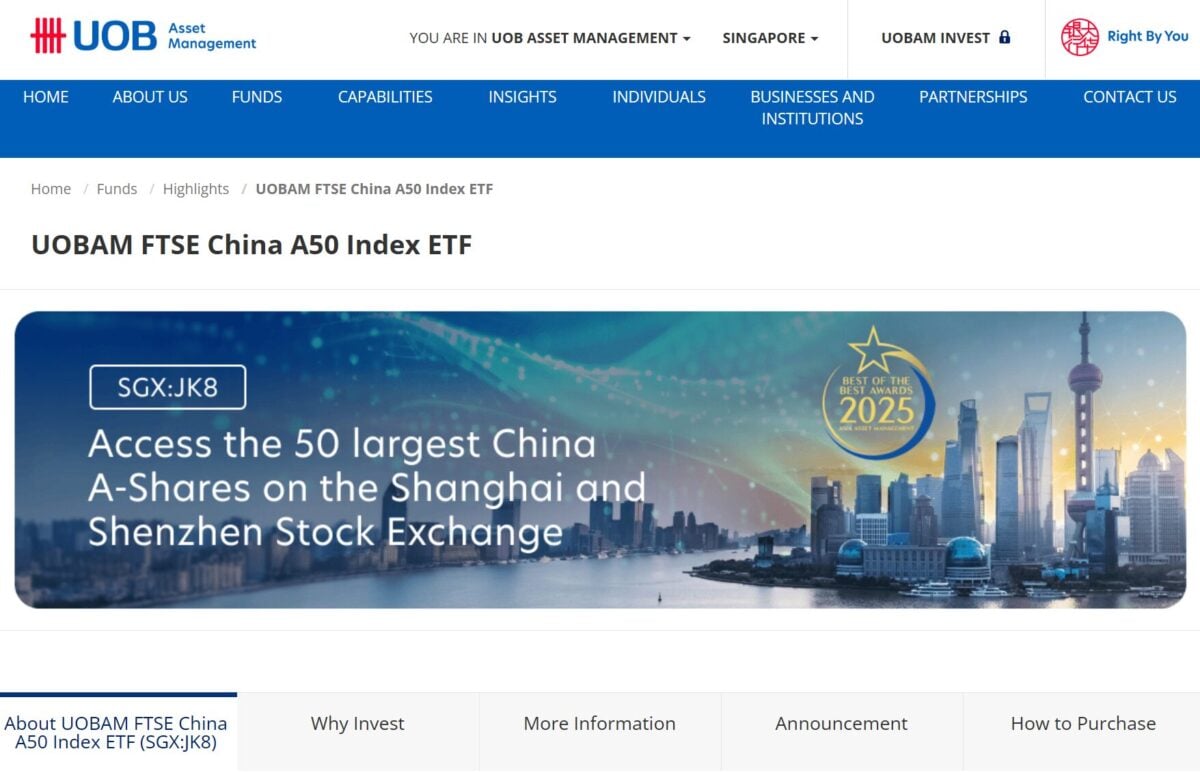Stocks on Singapore’s Straits Times Index (STI) are generally known for paying a decent dividend. As of 30 September 2024, the STI’s dividend yield was 4.99%. This is higher compared to other major country indexes, such as Hong Kong’s Hang Seng Index (HSI) which pays a dividend yield of 3.51% or the S&P 500 index in the U.S. which pays only 1.3%.
While the STI pays a more attractive dividend, this only paints half (or less) of the picture. We’re not looking at the growth of the index – aka, its total returns that also include price appreciation. Again, if we look at the HSI or S&P 500, they have a 1-year total return of 18.66% and 36.35% compared to the STI.
However, looking further back, the 5-year annualised return of the three indexes are 7.4% (for the STI), -19.0% (for the HSI) and 15.98% (for the S&P 500)
Benchmark IndexDividend Yield (as of September 2024)1-Year Total ReturnsAnnualised 5-Year Total ReturnsSingapore’s Straits Times Index4.99%17.7%7.4%Hong Kong’s Hang Seng Index3.51%18.66%-19.0%US’ S&P 500 Index1.3%36.35%15.98%
While the S&P 500 outperformed the STI over both 1-year and 5-year total returns, it does not provide comparable dividend payouts each year. We have to sell our investments in the S&P 500 if we want to unlock cash. This will also involve brokerage fees.
The Hang Seng Index (HSI), on the other hand, pay a slightly lower dividend payout, but has been plagued by negative performance in the past 5 years – even though it has outperformed the STI in the past 12 months.
Read Also: Guide To Dividend Investing In Singapore
Investors Who Benefit From Dividend Investing
When we embark on our investing journey, there are many strategies we can use to build our portfolio. For many in Singapore, dividend investing is an attractive and important way to generate a return. As we can tell from the figures, we would have been the most well off if we invested in the S&P 500, but it does not pay an attractive dividend.
Individuals – who are in retirement or partial retirement – may prioritise regular income to pay for their daily living expenses. Other individuals who are considering FIRE (Financial Independence, Retire Early) may also want to build their portfolio with income in mind. If we require regular income from an investment portfolio that does not pay a relatively good dividend (i.e. the S&P 500 Index), we would have to sell off parts of the investment. Apart from potentially having to sell at a low, during market downturns, we will also incur brokerage fees each time we sell a part of the portfolio.
Another way to think about income investing is that only strong and well-established companies that have healthy cash flows can afford to pay out dividends regularly – regardless of market booms and busts. However, due to the nature of such companies, they may not be in a high-growth stage. This may be one reason why total returns for STI companies lag behind companies on the S&P 500 Index.
Read Also: Complete Guide To Start Your REITs Investing Journey In Singapore
The 2 STI ETFs Do Not Pay The Same Dividend Yield
While the STI pays a dividend yield of close 4.99%, it doesn’t mean that investors automatically get this if we invest in an STI ETF. Apart from paying for brokerage fees to buy the STI ETF, we also have to pay a management fee and account for tracking errors.
There are two STI ETFs – the SPDR STI ETF or the Nikko AM STI ETF – that we can invest in. The SPDR STI ETF states that it’s distribution yield is 4.35% (as at 28 Oct 2024). While Nikko AM STI ETF does not state dividend information, it should be quite close as well.
Read Also: SPDR STI ETF VS Nikko AM STI ETF: What’s The Difference Between These 2 STI ETFs Listed On The SGX?
Individual Stocks On The STI Pay Out Different Dividend Yields
The Straits Times Index (STI) is made up of 30 of the largest and most liquid stocks in Singapore. As mentioned earlier, such companies typically have strong cash flows to pay out regular dividends, but may not be high-growth companies. In addition, the STI also comprises seven REITs – which are also known to pay out relatively good distributions regularly.
It should also be quite intuitive that all 30 constituents of the STI will pay a different distribution yield. We look at what the different stocks on STI are paying in dividend below:
No.STI Constituent StocksIndex WeightMarket Capitalisation (billion)Dividend Yield1DBS Group
(SGX: D05)22.99%$111.25.14%2Oversea-Chinese Banking (OCBC)
(SGX: O39)16.19%$68.95.63%3United Overseas Bank (UOB
(SGX: U11)12.11%$54.65.34%4SingTel
(SGX: Z74)6.59%$52.83.28%5CapitaLand Integrated Commercial Trust (CICT)
(SGX: C38U)3.18%$15.05.38%6Singapore Airlines (SIA)
(SGX: C6L)3.04%$19.27.43%7Jardine Matheson Holdings (JMH)
(SGX: J36)2.99%US$10.86.06%8CapitaLand Ascendas REIT
(SGX: A17U)2.91%$12.04.72%9Keppel Corporation
(SGX: BN4)2.85%$11.85.25%10Singapore Exchange (SGX)
(SGX: S68)2.48%$12.32.99%11CapitaLand Investment
(SGX: 9CI)2.13%$14.84.21%12ST Engineering
(SGX: S63)2.11%$14.63.43%13Yangzijiang Shipbuilding
(SGX: BS6)1.99%$10.12.57%14Wilmar International
(SGX: F34)1.97%$20.75.26%15Genting Singapore
(SGX: G13)1.6%$10.14.79%16Hongkong Land
(SGX: H78)1.53%US$8.75.57%17Sembcorp Industries
(SGX: U96)1.39%$9.32.69%18Mapletree Logistics Trust (MLT)
(SGX: M44U)1.37%$6.96.00%19Mapletree Industrial Trust (MIT)
(SGX: ME8U)1.33%$6.94.88%20Venture Corp
(SGX: V03)1.18%$3.95.55%21Thai Beverage
(SGX: Y92)1.17%$13.23.84%22Mapletree PanAsia Commercial Trust (MPCT)
(SGX: N2IU)0.89%$7.05.69%23Seatrium
(SGX: 5E2)0.89%$6.5–24Frasers Logistics & Commercial Trust (FLCT)
(SGX: BUOU)0.87%$4.16.37%25Jardine Cycle & Carriage
(SGX: C07)0.84%$11.05.53%26UOL Group
(SGX: U14)0.82%$4.62.78%27SATS
(SGX: S58)0.81%$5.90.38%28City Development
(SGX: C09)0.75%$4.71.54%29Frasers Centrepoint Trust
(SGX: J69U)0.75%$4.14.49%30DFI Retail Group
(SGX: D01)0.25%US$3.23.62%
*Dividend yield is based on SGX Stock Screener information, unless stated otherwise.
Dividend yield for CapitaLand Integrated Commercial Trust is retrieved from its website.
5 Best-Yielding STI Stocks
Three of the top five dividend-paying counters on the SGX are REITs – which isn’t unexpected. While Frasers Logistics & Commercial Trust saw its share price gain 5.0%, Mapletree PanAsia Commercial Trust remained stable, and Mapletree Logistics Trust lost 10.7% in value.
SIA is currently paying the best dividend yield on the STI, which is perhaps a reflection of the strong turnaround in fortunes for air travel, as well as SIA’s ability to capitalise on it.
Jardine Matheson Holdings is also part of the top dividend-paying stocks on SGX, but has seen its share price drop 7.3% in the past year.
All this points to the importance of investing in a diversified portfolio of dividend-paying stocks. While it would have been great to be an SIA investor in the last 12 months, those holding Mapletree Logistics Trust would have lost over 10% of their portfolio, offset by 6% they would have received in distributions.
No.STI StockDividend YieldPrice Appreciation (1-year)1Singapore Airlines (SIA)7.43%6.1%2Frasers Logistics & Commercial Trust (FLCT)6.37%5.0%3Jardine Matheson Holdings (JMH)6.06%-7.3%4Mapletree Logistics Trust (MLT)
(SGX: M44U)6.00%-10.7%5Mapletree PanAsia Commercial Trust (MPCT)5.69%0.1%
*Price change from SGX Stock Screener
Read Also: Complete Guide To Investing In The Straits Times Index (STI) ETFs In Singapore
The post How Much Dividends Do Stocks In The STI ETF Pay Out Each Year? appeared first on DollarsAndSense.sg.










